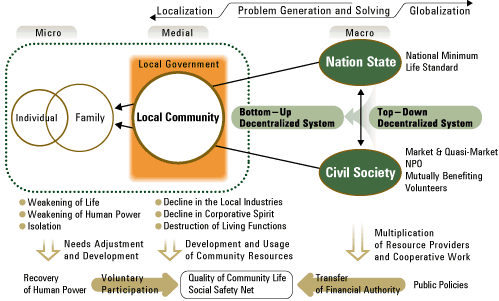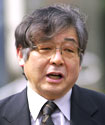|
The challenge of the Second Domain of our research can be simply stated as the scripting of a renaissance strategy for peripheral mountain regions in Japan. These mountain regions of Japan have suffered from a variety of problems, such as a decreasing fertility rate, an aging population, underpopulation, and a decline in local economies for the decade or so since the burst of the bubble economy. These regions also face other new challenges, such as mergers of neighboring towns and villages, and the triple reform of the local government tax and fiscal systems. In our Second Domain, we focus on three major research fields: (1) Study of a Welfare Society Development Model for Peripheral Mountain Regions; (2) Study of a Community Care Project Model for Peripheral Mountain Regions; and (3) Study of Methods of Creating Healthy Communities in Peripheral Mountain Regions – the Integration of Health, Medicine, and Welfare. |
 |
|
The first aim of our Second Domain research is to develop a program to foster specialists who can participate in and lead the local community renaissance in peripheral mountain regions, where the problems of decreasing fertility rates, the aging population, underpopulation, and the decline in local economies are becoming more serious. This program will create experts across the fields of health, medicine, and welfare, and enable them to lead the local community renaissance utilizing a variety of resources, such as human, property, geographic, and cultural, specific to each community. The second aim is to integrate small research groups in the same field into research centers, planned for establishment in Nagano, Iwate, and Kochi prefectures. The third aim is to develop a theoretical basis concerning community welfare and residential welfare based on community care and welfare society development model studies, so that such theories can eventually be woven into the renaissance strategy for peripheral mountain regions.
|
 |
|
Within the stream of the 21st century, a movement has arisen that is attempting to unfold the complex relationship between human life and the environment, from both the macro and micro viewpoints. In order to understand this complexity, collaboration and integration of natural science, social science, and the humanities, is becoming increasingly important. This amalgamation is generating research into a welfare society development model based on community welfare and residential welfare studies, and this research must now be placed in a practical and theoretical framework. The following figure shows the theoretical framework of the approach and problem-solving process concerning the welfare issues experienced by the families and communities in the peripheral mountain regions of Japan.
|

| Diagram of Concepts involved in Research on Welfare Society Development Model for Local Community Renaissance: Structure, Policy, and Practice (Sadahisa Noguchi) |
|
The premise required for future research of the welfare society development model to achieve a local community renaissance of peripheral mountain regions is to restructure the macro viewpoint, which attempts to understand the processes that generate modern welfare problems, and the micro viewpoint, which seeks the solution to the problems faced by the local community, into a theoretical framework. The Community Welfare Theories and the Residential Welfare Studies used in this research field are grounded on field work – studying actual cases and listening to the opinions of people involved in welfare work. Such a study method is indispensable for human resource cultivation, for forming local research centers, and for fact-based theorization. |
 |
The realization of a welfare community, which is the aim of community welfare studies, is the process by which citizens create an integrated social structure that support every community member throughout their life through self-motivated public and private collaborations within the local community. This is based on the principle of normalization, where every individual can be a dignified participant in society regardless of age or disability.
One of the theories used here is “the recreation of traditional culture.” This is a “voluntary-developmental” case study method that “opens up a variety of development possibilities by seeking in local traditions for keys to resolving some of the modern day difficulties that human beings face, and recreating such traditions to suit the new environment” (Tsurumi, K).
In the final stage, an integrated theorization of this research field and the establishment of research centers can be achieved through three concrete activities: lectures on “human resource cultivation” – including commemorative lectures and symposia; workshops – including practical work and seminars; and further field work. |
|
 |


Professor, Social Welfare Course, Graduate School of Social Welfare
Sadahisa Noguchi |
|
 |





